The competency assessment market is increasingly expanding as the needs of hiring companies are becoming more significant. This leads to the advent of several new evaluation tools like diagrammatic reasoning tests, which provides employers a thorough assessment of candidates’ logical ability and problem-solving skills. This is also a commonly used exam developed by some reputed test publishers like Aon or Saville.
This article will provide a comprehensive introduction to this test type, free sample questions & answer guide, and tips to ace this tricky aptitude test.
Table of Contents
What are diagrammatic reasoning tests?
Diagrammatic reasoning tests are aptitude tests used to assess your problem-solving skills and abstract reasoning ability. Specifically, you have to work with diagrams and flowcharts to find the rules governing given operations and apply them to deduce a logical output.
The most common question type you may encounter in this assessment can be finding the input/output of a diagram based on defined rules of operators. Sometimes, it can progress to a higher level in which you have to recognize the underlying effects of the operators and then apply them to solve the required diagram.
Considering skills required, accumulated industry knowledge is not the optimal tool in this assessment; instead, your natural cognitive abilities will help you immensely in mastering this type of test.
Through the test, hiring companies want to measure your intelligence and logical thinking, which are useful competencies across all industries. That’s why diagrammatic reasoning tests are often standardized regardless of the position you apply for or companies that use them, rather than customized for specific roles like numerical or verbal reasoning tests.
Diagrammatic reasoning test vs. Abstract reasoning test
Although closely related and assessing the same skills, diagrammatic reasoning tests and abstract reasoning tests are slightly different based on the format of the questions. Below is a table comparing between these 2 types of aptitude tests:
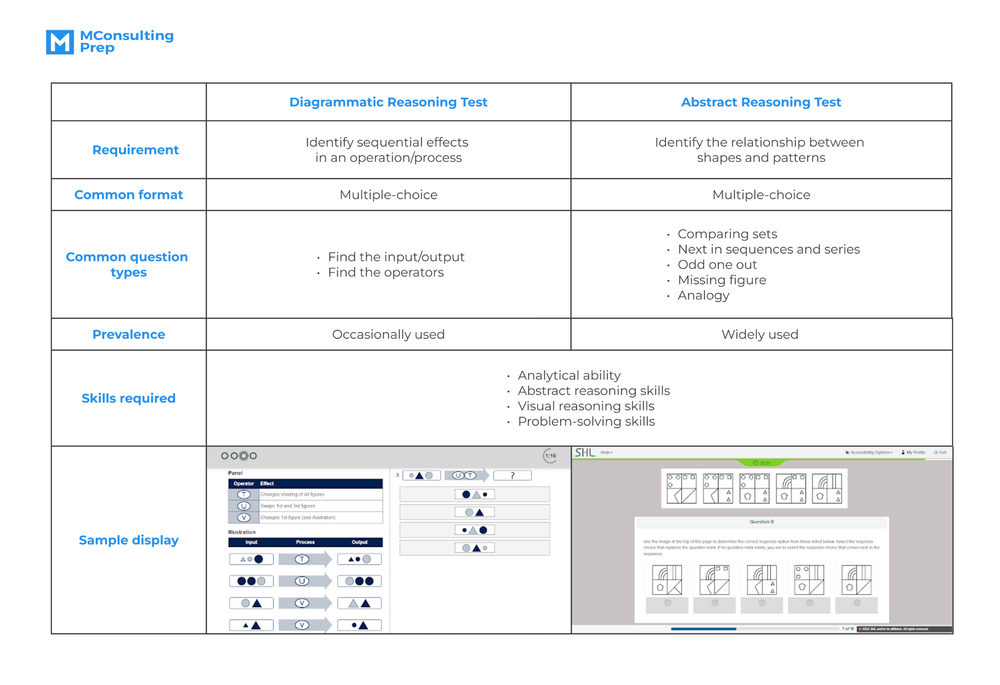
What to expect in diagrammatic reasoning tests
Diagrammatic reasoning tests vary in difficulty levels, including 2 main question types: Simple and Advanced. They are all about processing an abstract operation, yet differing from each other by whether the effects are defined. Let’s look closer into these 2 levels:
Simple diagrammatic reasoning
In the simple diagrammatic reasoning questions, you are presented with a diagram followed by a set of effects for the operators. Your job is to conduct the operations following the rules, generating a correct outcome. Given the function of the operators, you may have to identify either the input or output. Here are some examples of how this question will be:
Question 1:
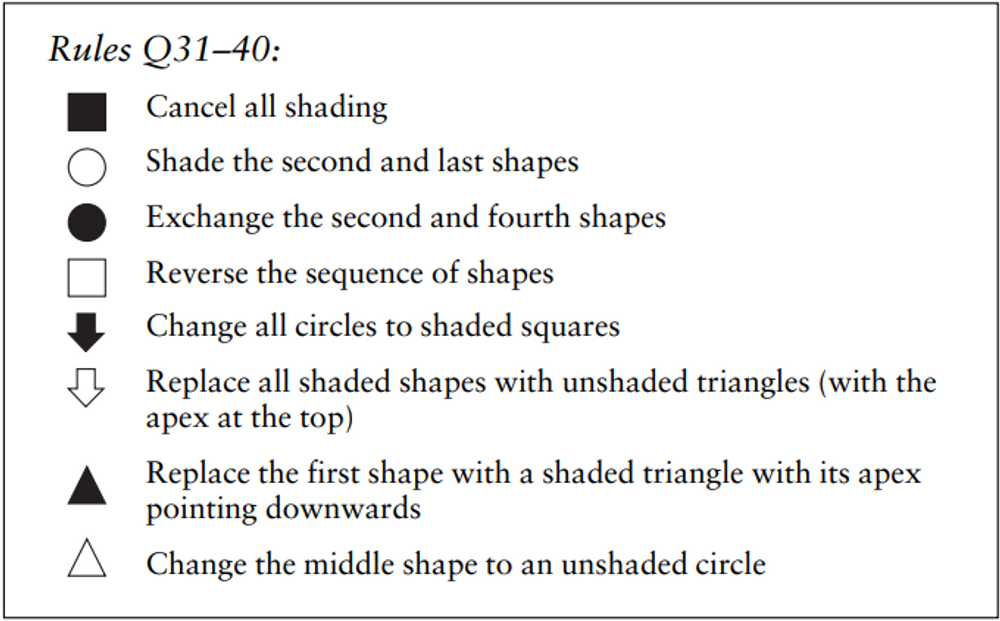
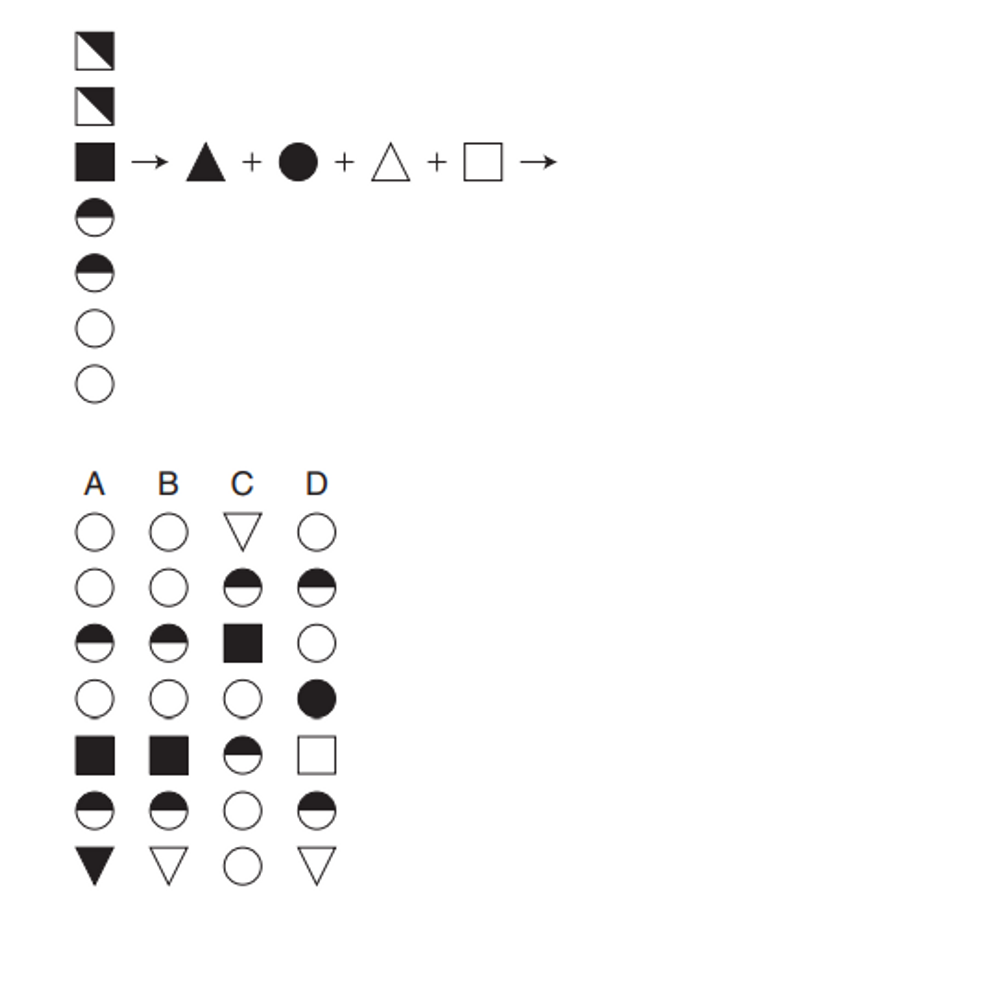
Source: “How to Pass Diagrammatic Reasoning Tests” by Mike Bryon
Answer: A
Explanation:
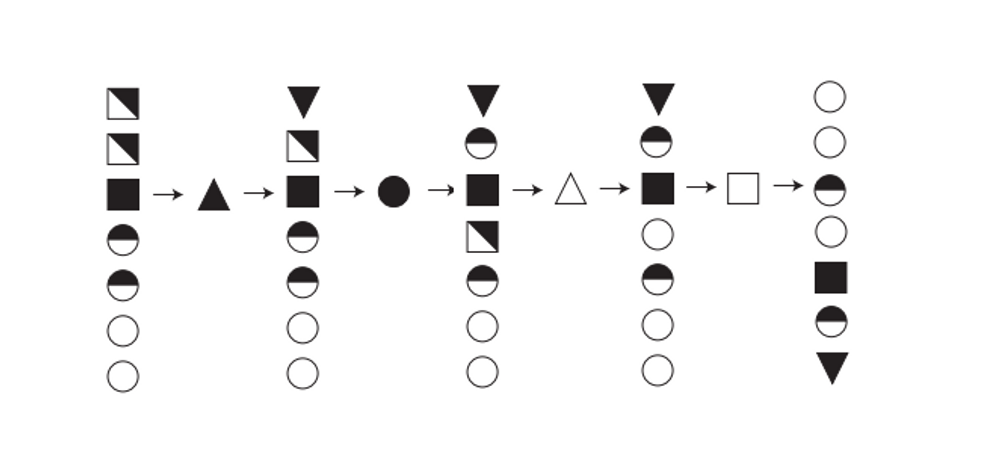
Question 2:
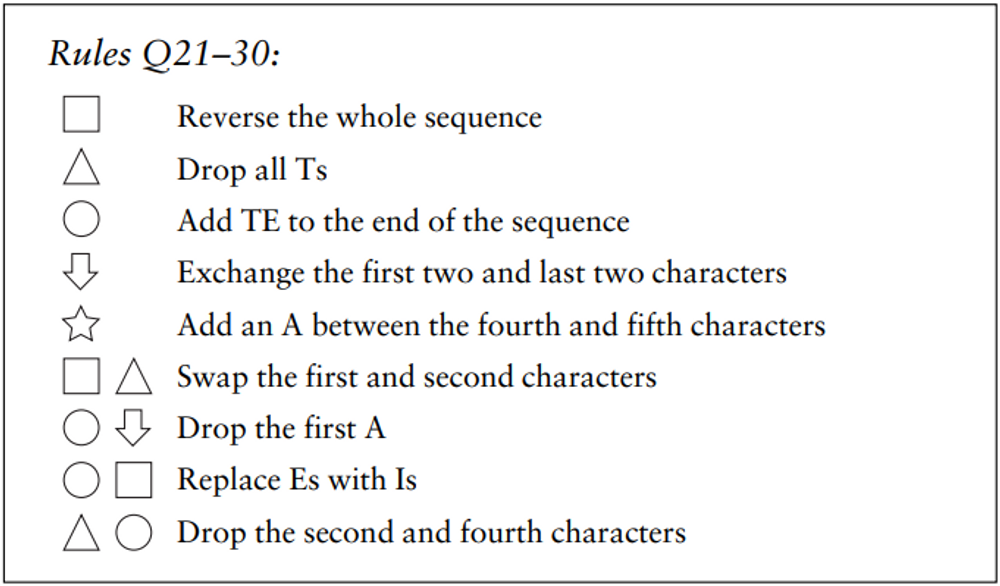
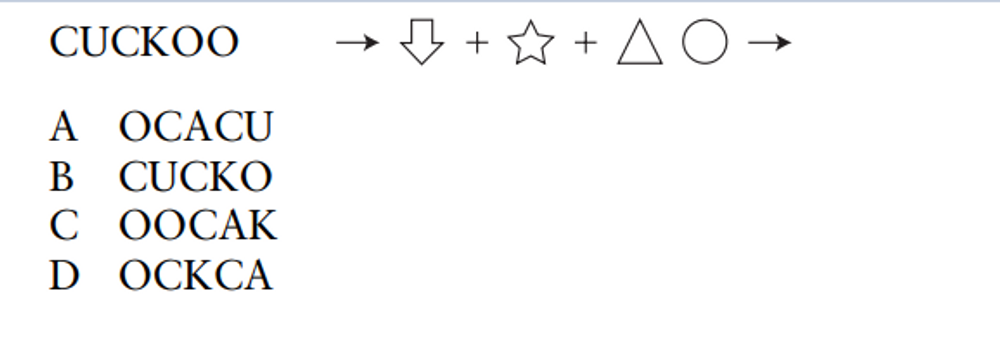
Source: “How to Pass Diagrammatic Reasoning Tests” by Mike Bryon
Answer: A
Explanation:
The down arrow – Swap “CU” with “OO”: OOCKCU
The star – Add an A between the K and the second C: OOCKACU
The triangle and circle -Remove the second O and the K : OCACU
So, the correct answer is A.
Advanced diagrammatic reasoning
Questions at advanced diagrammatic reasoning tests also require you to find the input/output of a diagram based on a given process. However, unlike simple diagrammatic reasoning questions, the function of each operator is not defined for you. Your task is to determine the effects of operators and apply them to the required diagram to arrive at a logical answer.
Question 3:
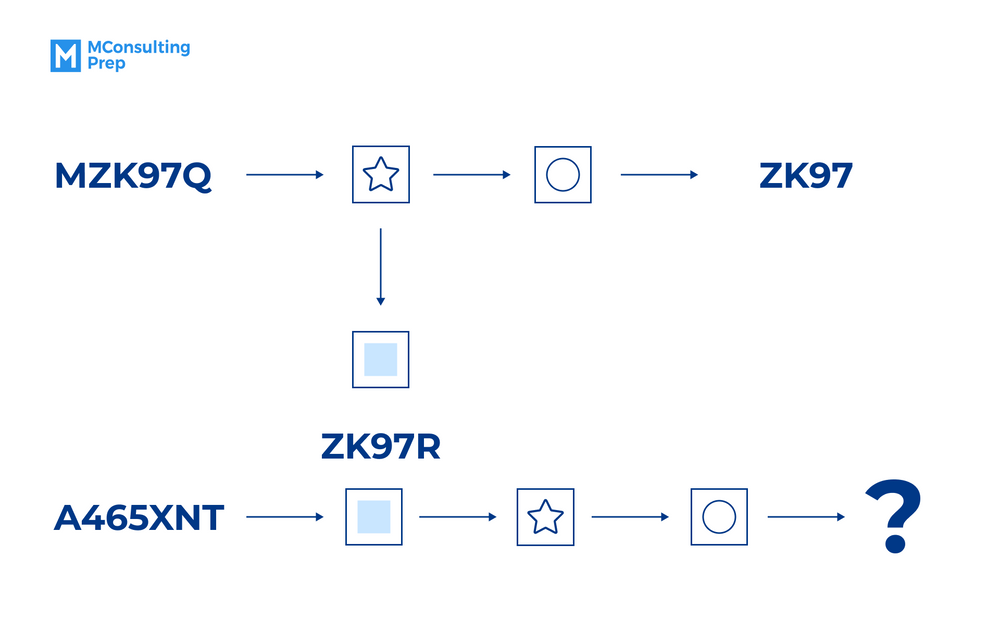
Replace the question mark with a correct code:
A. 456XN
B. A465X
C. 465XN
D. A65XU
Answer: C
Explanation:
Through the given diagram, we can infer the effect of the 3 operations as follow:

Therefore, the question mark can be generated by the following steps:

KEY TAKEAWAYS: One helpful tip for this question type is to solve the operation that two or more branches have in common. First, you need to identify the common effects on intersected branches; for instance, in the example above, both operations with “the star” have their first letter missing. Therefore, we can infer that the function of “the star” is removing the first character.
Question 4:

Answer: A
Explanation:
Follow the tips provided above, we can identify the effect of the 4 operators:
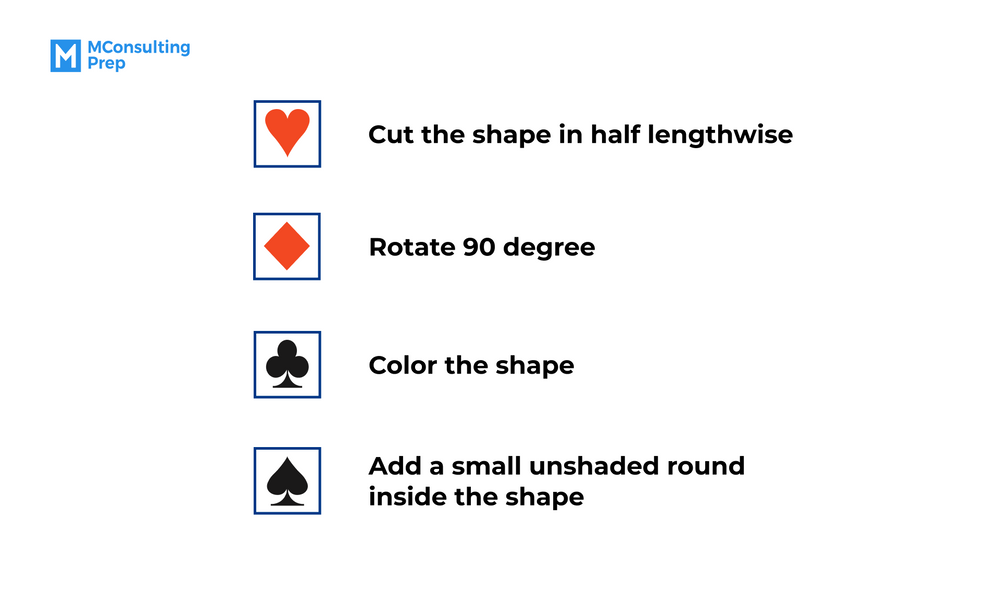
The missing shape is a shaded pentagon with a small hole in the center.

Although both levels ask you to give the input/output of a diagram, the main difference is that the effects of operators are defined for you in simple questions, while in advanced questions, you have to figure it out by yourself. However, with our useful key takeaway above, now advanced diagrammatic reasoning questions are easy as pie!
Test providers that use diagrammatic reasoning tests
Two of the best-known test publishers that have diagrammatic reasoning tests are Aon and Saville – the producers of various assessment tests for reputed companies. Requiring the same skills from candidates, they are different in the format, numbers of questions or test duration. Let’s look at some example below to get an overview of the questions from these test providers:
Aon
Aon-style diagrammatic reasoning questions are in the format of Aon Switch Challenge, requiring you to identify the operator that altered the order of given shapes. There are 6 minutes for you to answer as many questions as possible in this test. Below is the sample interface of this test:

Source: AON
Answer: 4123
Explanation:
- Step 1: Encode each shape with numbers in chronological order. “1” for the pink round, “2” for the purple star, “3” for the yellow cross and “4” for the blue triangle.
- Step 2: Rewrite the output in that numerical arrangement. We give the blue triangle the number four, so “4” is the first digit. The second digit will be the number “1”, representing the pink round. Just like that, we have the correct answer, 4123.
Saville
Saville diagrammatic reasoning tests ask you to find the missing input, operator, or output of a given process. This type is similar to simple diagrammatic reasoning questions we have mentioned above, as the effect of all operators are fully defined. The test includes 23 questions within a time limit of 24 minutes, exemplifying as the picture below:
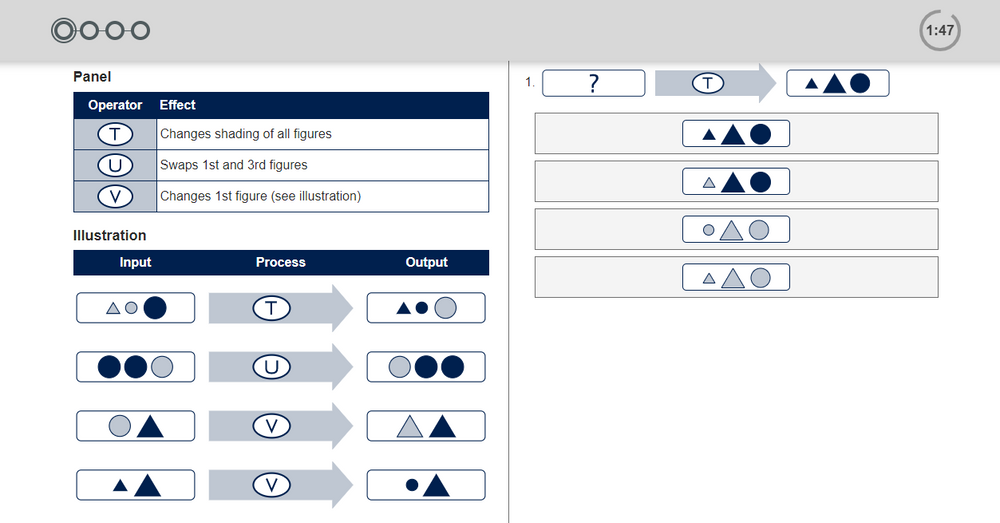
Source: Saville
Answer: D
Explanation:
The effect of “T” is changing the shading of all figures, so the color of the input has been altered but the sequence order remains the same.
Therefore, the input must be in light color.
Tips to ace diagrammatic reasoning tests
Needless to say, diagrammatic reasoning tests are among the most challenging assessments since they focus on your fluid intelligence and abstract reasoning skills. Uncommon concepts can appear despite beforehand practice. However, along with the helpful key takeaway to solve advanced questions as above, we’re ready to provide you with practical guidelines when handling this taxing exam:
- Sharpen your logical thinking: As you know, logical reasoning skills are of utmost importance in diagrammatic reasoning tests. Therefore, it is crucial to practice this aptitude as much as you can. Brain teasers like Sudoku, Puzzles, or Crosswords can be effective ways to enhance your intelligence and logical ability.
- Generalize typical techniques: These assessment tests often use a standardized format of processing a diagram to find an input/output or operator. Thus, there will be some handy tricks like the one we give you in the Advanced questions part, which you can draw by yourself through enough practice.
- Familiarize yourself with typical question types: You can also practice assessment tests from prestige test providers, such as SHL, Aon, or Saville, to familiarize yourself with the test. That way, you won’t be surprised by recruitment exams’ different formats and time limits.
Practice with MConsultingPrep
To sharpen your thinking, try our a with over 1,400 questions on numerical, verbal, and logical reasoning. We also provide study guides for each type of question, so you can understand the reasoning behind them.
Additionally, we offer free mock tests! You can try free samples of numerical, verbal, and logical reasoning questions to see what they’re like.
/filters:quality(75)//case_thumb/public/1699589977462_aptitude_tests_package_4_x.png)